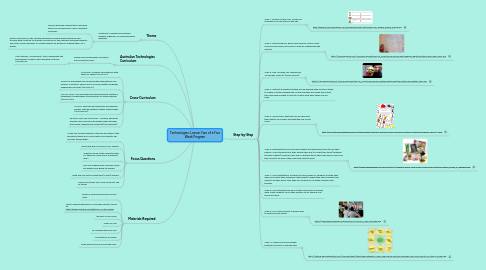
1. Theme
1.1. Construct a useable personalised desktop organiser, re-using discarded materials
1.1.1. Explore everyday rubbish items and how these can be reused for new or different purposes.
1.1.2. At the conclusion of this learning experience each student should be able to:Work with a partner to evaluate a minimum of two reusable discarded objects and list as many new ways to use the objects by writing or drawing them on a poster.
2. Focus Questions
2.1. I’d like you to think outside of the box and think of the wonderful things you could create from objects we normally throw away?
2.2. What new ways could you use…object?
2.3. What are some of the characteristics of…that you could use in a different way?
2.4. Can you imagine how someone could use what you're going to design?
2.5. What did you notice about their (a pairs) pieces?
2.6. How do you think you could construct one of those?
3. Cross-Curriculum
3.1. SCIENCE: Compare observations with those of others (ACSIS041)
3.2. SCIENCE: Represent and communicate observations and ideas in a variety of ways such as oral and written language, drawing and role play (ACSIS042)
3.3. VISUAL ARTS: Use and experiment with different materials, techniques, technologies and processes to make artworks (ACAVAM107
3.4. MATHS: Describe and draw two-dimensional shapes, with and without digital technologies (ACMMG042)
3.5. DESIGN AND TECHNOLOGY: Visualise, generate, develop and communicate design ideas through describing, drawing and modelling (ACTDEP006)
4. Australian Technologies Curriculum
4.1. Design and Technologies Processes and Production Skills
4.1.1. Use materials, components, tools, equipment and techniques to safely make designed solutions ACTDEP007
5. Materials Required
5.1. Reduce, Reuse and Recycle column chart
5.2. IWB to display Repurpose 4 Everyday Objects found at: http://www.youtube.com/watch?v=0-dtICAo8lw
5.3. 15x pairs of Pair cards
5.4. Timer on IWB
5.5. 2x reusable items per pair
5.6. 15x sheets of A3 paper
5.7. Scrap paper for plan and rough copy.
6. Step-by-Step
6.1. STEP 1: Conduct Think, Pair, Square for students to re-cap each of the 3R’s.
6.1.1. http://www.classroomcapers.co.uk/media/teacher-talk/Think-pair-square-article-image.jpg
6.2. STEP 2: Revisit Reduce, Reuse and Recycle column chart from previous lesson and discuss how we categorised the objects.
6.2.1. http://4.bp.blogspot.com/-QHMDY9qfFIw/Tbo-ye_FHpI/AAAAAAAACQE/PKx6sgrVkRg/s320/will+and+kate+036.JPG
6.3. STEP 3: Play YouTube clip “Repurpose 4 Everyday Objects” (2mins:57secs)
6.3.1. http://4.bp.blogspot.com/-QHMDY9qfFIw/Tbo-ye_FHpI/AAAAAAAACQE/PKx6sgrVkRg/s320/will+and+kate+036.JPG
6.4. STEP 4: Instruct students that they will be working with a partner today to create a poster showing two of the everyday discarded items that the class have brought in and list as many new ways these can be used.
6.5. STEP 5: Inform them that they will be choosing their partner for today’s task with the use of pair cards.
6.5.1. http://mcdn.teacherspayteachers.com/thumbitem/Partner-Picking-Cards-randomly-partner-students/original-450271-1.jpg
6.6. STEP 6: Distribute the cards to each student and allow them time to find their partner. Once students find their partner they are to collect two items (between the two of them) from the class pile of reusable items, their own pencil cases and then move to an area of the room they wish to work.
6.6.1. http://www.bawbawshire.vic.gov.au/files/4130e8cb-984a-46af-b3d0-a09400994ffe/recyclables_found_in_garbage.jpg
6.7. STEP 7: Class distributors to hand out scrap paper for students to write their ideas or practice their drawings if they want to.When they feel confident and ready to do their good copy they can receive an A3 sheet of paper from teacher.
6.8. STEP 8: Once students are back in their desks and all packed away invite students to pin their posters up on the wall one group at a time.
6.9. STEP 9: As a class conduct a gallery walk to observe each other’s.
6.9.1. http://johnrinker.edublogs.org/files/2012/02/IMG_2765-2hc0ete.jpg
6.10. STEP 10: Observe and encourage positive discussion along the way.
6.10.1. http://static6.depositphotos.com/1005979/663/i/950/depositphotos_6637468-Praise-Positive-Reviews-and-Comments-on-Sticky-Notes.jpg
